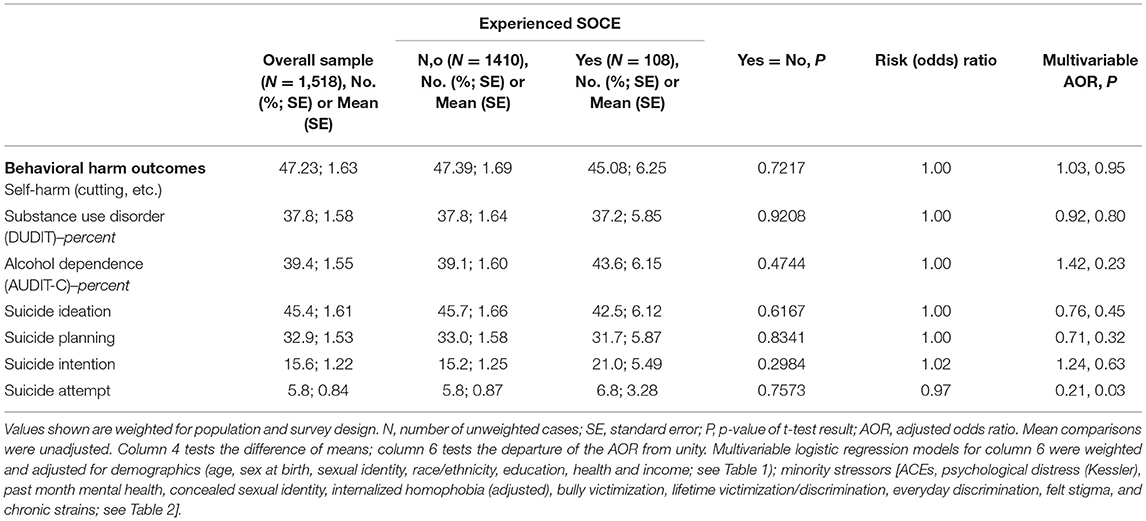
94% of researchers rate our articles as excellent or good
Learn more about the work of our research integrity team to safeguard the quality of each article we publish.
Find out more
CORRECTION article
Front. Psychol., 26 April 2022
Sec. Health Psychology
Volume 13 - 2022 | https://doi.org/10.3389/fpsyg.2022.906401
This article is a correction to:
Absence of Behavioral Harm Following Non-efficacious Sexual Orientation Change Efforts: A Retrospective Study of United States Sexual Minority Adults, 2016–2018
 D. Paul Sullins1,2*
D. Paul Sullins1,2*by Sullins, D. P. (2022). Front. Psychol. 13:823647. doi: 10.3389/fpsyg.2022.823647
In the original article, there was an error. The description of “current suicidality” stated that this was “indicated by having engaged in the behavior at least once in the past year” but failed to include that this was measured at both Wave I and the Wave 2 one-year follow-up. This information is necessary in order to replicate the findings.
A correction has been made to Measures, Behavioral Harm, Suicidal Behavior. The corrected paragraph is shown below.
Suicidal behavior was assessed using an instrument developed by the Unite States Army to assess risk in service members (Nock et al., 2014). Four questions asked, “Did you ever … in your life have thoughts of killing yourself?”; … have any intention to act on thoughts of wishing you were dead or trying to kill yourself?; … think about how you might kill yourself (e.g., taking pills, shooting yourself) or work out a plan of how to kill yourself?; … make a suicide attempt (i.e., purposefully hurt yourself with at least some intention to die)?” Response options were “No,” “Yes, once,” and “Yes, more than once.” Follow-up questions for the yes responses asked how old the respondent was when they engaged in the suicide behavior or both the first and most recent of multiple instances of that behavior. For each behavior, current suicidality was indicated by having engaged in the behavior at least once in the past year, as indicated at Wave 1 or Wave 2.
In the original article, there was also a mistake in Table 3 as published. The N for the overall sample and in the legend was incorrectly shown as 833. It should be 1,518. The corrected Table 3 appears below.

Table 3. Unadjusted means and risk ratios, and adjusted AORs, showing current behavioral harm by experiencing SOCE, counts, and weighted proportions: probability sample of sexual minorities, United States, 2016–2018 (N = 1,518).
The author apologizes for these errors and states that they do not change the scientific conclusions of the article in any way. The original article has been updated.
All claims expressed in this article are solely those of the authors and do not necessarily represent those of their affiliated organizations, or those of the publisher, the editors and the reviewers. Any product that may be evaluated in this article, or claim that may be made by its manufacturer, is not guaranteed or endorsed by the publisher.
Keywords: sexual orientation change efforts, conversion therapy, minority stress, suicide, sexual orientation
Citation: Sullins DP (2022) Corrigendum: Absence of Behavioral Harm Following Non-efficacious Sexual Orientation Change Efforts: A Retrospective Study of United States Sexual Minority Adults, 2016–2018. Front. Psychol. 13:906401. doi: 10.3389/fpsyg.2022.906401
Received: 28 March 2022; Accepted: 07 April 2022;
Published: 26 April 2022.
Edited by:
Stephen Sammut, Franciscan University of Steubenville, United StatesReviewed by:
Avak Howsepian, University of San Francisco, United StatesCopyright © 2022 Sullins. This is an open-access article distributed under the terms of the Creative Commons Attribution License (CC BY). The use, distribution or reproduction in other forums is permitted, provided the original author(s) and the copyright owner(s) are credited and that the original publication in this journal is cited, in accordance with accepted academic practice. No use, distribution or reproduction is permitted which does not comply with these terms.
*Correspondence: D. Paul Sullins, c3VsbGluc0BjdWEuZWR1
Disclaimer: All claims expressed in this article are solely those of the authors and do not necessarily represent those of their affiliated organizations, or those of the publisher, the editors and the reviewers. Any product that may be evaluated in this article or claim that may be made by its manufacturer is not guaranteed or endorsed by the publisher.
Research integrity at Frontiers

Learn more about the work of our research integrity team to safeguard the quality of each article we publish.